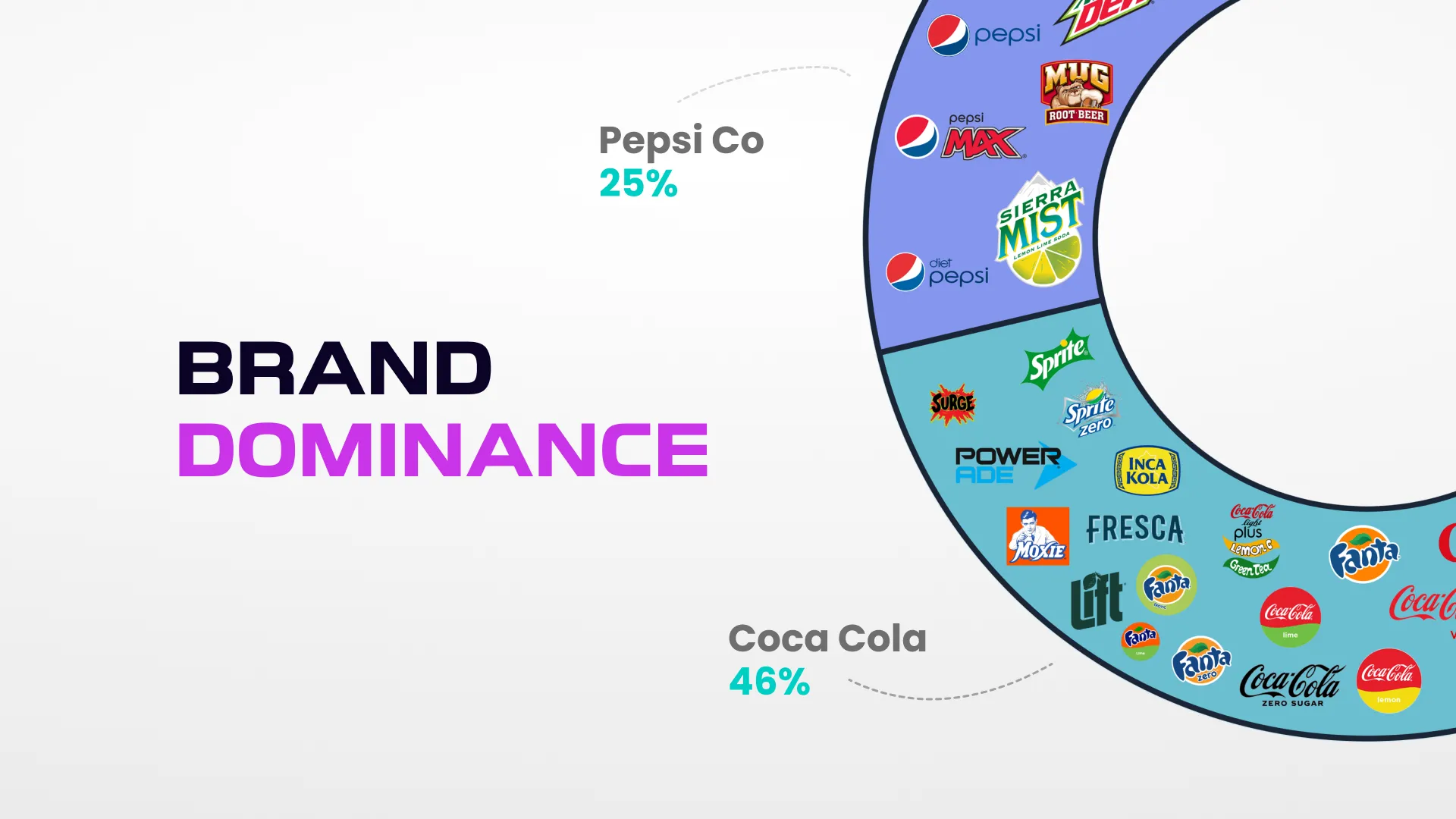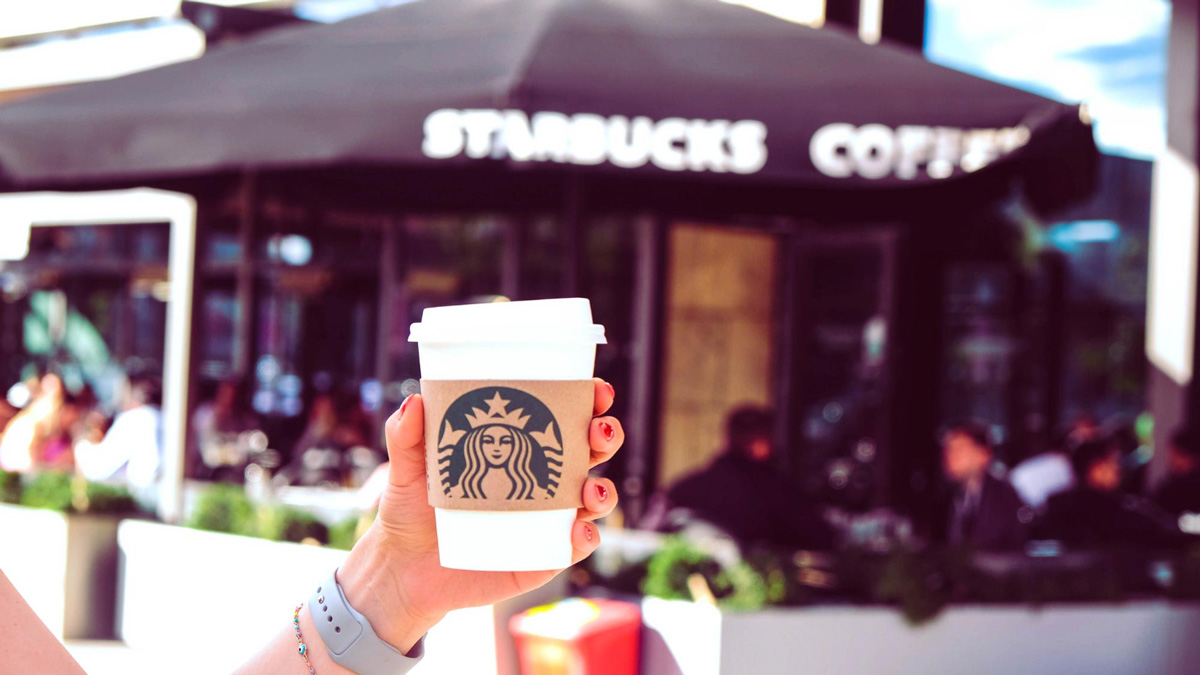
Brands are constantly facing the competitive landscape, striving to carve out their niche in the market. But have you ever wondered why certain brands dominate effortlessly while others struggle to gain traction?
When you achieve brand dominance, success isn’t merely about offering a product or service – it’s about crafting a narrative that captures your audience and distinguishes you from the competition.
Consider Apple, for instance. What comes to mind when you think of cutting-edge technology and sleek design? For many, it’s the iconic Apple logo adorning their devices.
In this blog post, we’ll explore the concept of brand dominance and the strategies successful companies employ to rise above the competition.
Definition of Brand Dominance
Brand dominance is when one brand rules over others in its market. You see it everywhere, from tech giants to soda companies. It’s like being the king of the hill in your neighborhood. Customers think of that brand first, and others follow along.
A dominant brand effortlessly stands out among competition, capturing the attention and trust of consumers with your compelling offerings and consistent quality. You achieve it by building a reputation for trustworthiness and reliability that resonates with your audience.
Therefore, it is more than just being top of mind; it’s about owning your market. The goal is to surpass competitors and earn unwavering loyalty, establishing your brand as the go-to choice for consumers.
In other words, brand dominance requires more than just market share or revenue – it’s about shaping perceptions and building strong emotional connections with your customers.
Think about iconic brands like Apple or Nike. It’s not just about their products; it’s about the lifestyle, the values, and the identity they represent. You’re not just buying a phone or a pair of shoes; you’re buying into a whole world of aspiration and belonging.
When you dominate a market, you become synonymous with excellence and trust. Customers don’t just choose you; they choose you repeatedly because they believe in what you stand for.
That’s the ultimate power of brand dominance: creating a tribe of loyal followers who wouldn’t dream of going anywhere else.
It is a never-ending adventure that requires continuous evolution and adaptation. You need to deliver on your promises time and again. To stay ahead of the curve, you must anticipate market shifts and embrace innovation to maintain your competitive edge.
Investing in research, development, and strategic marketing initiatives reinforces your brand’s dominance and solidifies your position as an industry leader.
Ultimately, brand dominance is more than just transactions – it’s about forging lasting connections with your customers and crafting a memorable impact that sets you apart from the competition.
Brand Dominance Vs. Top-of-Mind Awareness
Brand dominance represents the highest level of market influence. At this peak, your brand stands out prominently over its rivals, securing a unique position that earns consumer loyalty and admiration.
Your brand becomes synonymous with excellence, trust, and reliability. Every move you make resonates with your audience, shaping their perceptions and preferences. You set the standards others aspire to emulate, setting the tone for the entire industry.
With brand dominance, you’re not just a player; you’re the game-changer, dictating the rules and direction of the market.
On the other hand, top-of-mind awareness is about being the first brand that comes to people’s minds when they think of a product or service. You may not necessarily dominate the market, but you hold a special place in people’s minds.
Whether it’s smartphones, soft drinks, or sneakers, being top of mind means your brand is the default choice, the one that springs to mind without any prompting.
Consumers typically consider only the top three brands in their decision-making process, making top-of-mind awareness a crucial battleground for brands vying for consumer attention and preference.
While brand dominance and top-of-mind awareness share common ground in their quest for prominence, they operate on different levels. Brand dominance concerns control and influence, while top-of-mind awareness focuses on immediate recall and recognition.
Both are valuable assets in the competitive landscape but serve distinct purposes in brand strategy. Whether you aim to dominate the market or be the first choice in consumers’ minds, understanding the nuances and strategies of these concepts can help you achieve sustained success in your branding efforts.
For a related read, check out: What Is Top Of Mind Brand Awareness And How To Measure It?
Digital Brand Dominance
Digital dominance refers to your ability to establish a commanding presence and influence in the vast digital landscape. In simple terms, it’s about making sure that when people think about your industry or niche, they think of you first.
Achieving digital brand dominance means you’re not just another player in the digital arena; you’re the leader, the go-to authority, and the top choice for consumers in your market.
Your online presence is more important than ever in today’s hyperconnected world. More than having a website or social media presence is needed; you need to stand out, make an impact, and be the brand that people remember and trust.
By focusing on consistency, engagement, innovation, and analytics, you can establish yourself as a leader in your industry or niche and achieve sustained success in the digital age.
Local Brand Dominance
You might initially perceive brand dominance as something reserved for global corporations with vast resources and extensive marketing budgets. However, local brand dominance can be just as impactful, if not more so, in shaping the success of your business within your community.
Imagine you’re walking down the main street of your town, passing by storefronts and boutiques. Amidst the crowd, a charming café always seems to draw a crowd. What sets this café apart from the chain coffee shops nearby?
It’s not just the quality of their brew or the ambiance of their space – it’s the sense of community they’ve cultivated through their brand.
Local brand dominance isn’t solely about outspending your competitors on flashy advertising campaigns. It’s about forging genuine connections with your customers and embedding your brand into the fabric of their daily lives.
By actively engaging with your customers, participating in local events, and supporting causes that matter to your community, you can cultivate a sense of loyalty and belonging that transcends mere transactions.
Global Brand Dominance
Consider the iconic brands that transcend borders and cultures, like Coca-Cola or McDonald’s. What sets them apart isn’t just their products or services; it’s the universality of their brand identity and the consistency of their messaging.
Global brand dominance is achieved over time; it results from careful planning, relentless innovation, and strategic expansion. It’s about understanding diverse markets’ unique needs and preferences and tailoring your brand message accordingly.
Consistency and authenticity are paramount whether entering new territories or competing globally. Take tech giants like Apple or Amazon, for instance. Their products and services have become indispensable in our daily lives, thanks partly to their unwavering commitment to user experience and customer satisfaction.
By continuously pushing the limits of innovation and anticipating market trends, they’ve solidified their positions as leaders in their respective industries, commanding loyalty and admiration from customers around the globe.
Examples of Brand Dominance
Understanding the concept of brand dominance is crucial in the competitive landscape and securing your position in the market. To grasp this concept more effectively, let’s explore some compelling examples across various industries, illustrating how different brands have achieved dominance and what strategies they employed to get there.
Apple<
Apple can provide valuable insights into establishing and maintaining a strong market presence to achieve brand dominance. When you think of Apple, what comes to mind? The sleek design of their products, the seamless integration of hardware and software, and the unparalleled customer experience.
These factors have contributed to Apple’s position as a leader in the technology industry. You can learn from Apple’s success by understanding their key strategies to achieve brand dominance.
One of the most significant factors contributing to Apple’s brand dominance is their unwavering commitment to innovation. From the introduction of the iPod to the revolutionary iPhone and beyond, Apple has consistently pushed the limits of technology, setting the standard for innovation in the industry.
By constantly evolving and introducing groundbreaking products, Apple has captured consumers’ imaginations and solidified its position as a dominant force in the market.
Examining Apple as an example of brand dominance reveals the importance of innovation, user experience, and brand loyalty in establishing a strong market presence. By mastering and implementing these key strategies, you can strengthen your brand and solidify your position as a dominant force in your industry.
Tesla
The cutting-edge electric vehicles, the visionary leadership of Elon Musk, and the vibrant fan base have all contributed to Tesla’s position as a leader in the automotive industry.
One key factor driving Tesla’s brand dominance is its commitment to innovation. From the groundbreaking electric vehicles it produces to its advancements in renewable energy technology, Tesla has consistently pushed the boundaries of what’s possible.
Tesla’s brand dominance is also fueled by their focus on sustainability and environmental consciousness. Tesla’s commitment to producing electric vehicles and renewable energy solutions resonates strongly with consumers in a world increasingly mindful of climate change and environmental sustainability.
Tesla’s brand dominance is evident in their strong brand loyalty and advocacy. Tesla owners are not just customers but enthusiastic supporters who proudly advocate for the brand and its mission.
This level of brand loyalty shows Tesla’s ability to create products that resonate deeply with consumers and inspire passion and loyalty.
Disney
Disney is synonymous with magic, imagination, and storytelling. When you think of Disney, you’re transported to a world of beloved characters, enchanting theme parks, and unforgettable experiences.
Disney’s entertainment industry dominance spans movies, television, theme parks, and merchandise. With iconic characters like Mickey Mouse, beloved movies like The Lion King, and immersive theme park attractions, Disney has captured the hearts of audiences of all ages.
When you engage with Disney through a movie, a visit to a theme park, or purchasing merchandise, you’re not just consuming entertainment but becoming part of a magical world that sparks joy and wonder.
Nike
From their cutting-edge athletic footwear to their high-performance apparel, Nike constantly pushes the boundaries of design and technology. By consistently delivering innovative products that meet the needs of athletes and consumers, Nike has established itself as a trusted and respected brand in the industry.
Nike’s brand dominance represents their powerful marketing and branding strategies. The iconic swoosh logo and the memorable “Just Do It” slogan have become synonymous with the Nike brand, evoking a sense of inspiration and empowerment.
Through strategic partnerships with top athletes and celebrities, Nike has aligned its brand with excellence and athleticism, further solidifying their position as a leader in the market.
Nike’s brand dominance is evident in their strong brand loyalty and advocacy. Nike customers are not just consumers but passionate supporters who proudly wear the Nike logo and advocate for the brand.
Nike’s brand dominance underscores the importance of innovation, branding, and brand loyalty in building a strong brand. Adopting and integrating these strategies can strengthen your brand and establish yourself as a dominant force in your industry.
Amazon
Amazon has revolutionized the shopping experience by providing an unprecedented level of ease and selection in the realm of online retailing. When you go to the website of Amazon, you are presented with a wide range of things, ranging from technological devices to necessities for the home, all of which can be purchased with the simple click of a button.
Amazon’s continuous emphasis on customer happiness and innovation is the primary reason for the company’s dominant position in the retail business. Amazon has established itself as the industry leader in online shopping by employing features such as one-click buying, Prime membership advantages, and alternatives for quick shipping.
When you shop on Amazon, you’re not just buying products but engaging with a brand that prioritizes efficiency, reliability, and customer experience.
Coca-Cola
When you think of Coca-Cola, you’re immediately transported to a world of refreshing beverages and timeless branding. Coca-Cola’s dominance in the soft drink industry is unparalleled, with its name recognized globally.
From its classic red cans to its iconic logo, Coca-Cola has mastered the art of branding, cultivating a sense of familiarity and nostalgia for consumers worldwide. With its extensive distribution network and strategic marketing efforts, Coca-Cola has solidified its position as the leader in the beverage market.
When you see the Coca-Cola logo, you’re not just seeing a brand; you’re experiencing a symbol of quality, tradition, and joy.
Google is synonymous with the internet, serving as the gateway to vast information at your fingertips. When you need to find something online, you turn to Google, confident that it will deliver accurate and relevant search results.
Google’s dominance in the search engine market shows its intuitive interface, powerful algorithms, and continuous innovation. With features like Google Maps, Gmail, and YouTube, Google has expanded its reach beyond search and integrated into our daily lives.
When you use Google, you’re not just using a search engine; you’re accessing a wealth of knowledge and resources that empower you to explore the world.
However, Google’s meteoric rise to dominance also posed a unique challenge: its name became so widely used that it became a generic term for searching online. When you hear someone say, “Google it,” you instinctively know they’re referring to conducting an online search, regardless of the search engine they use.
While this may confirm Google’s success, it also presented a legal and branding challenge for the company. Maintaining the distinctiveness of the Google brand while preventing its name from becoming a generic term for search engines required strategic legal and marketing efforts.
To address this challenge, Google started a campaign to protect its trademark and reinforce its brand identity. Through targeted marketing initiatives and legal actions, Google sought to preserve the uniqueness of its brand and ensure that consumers continued to associate “Google” with its search engine specifically.
By emphasizing the features and benefits that set Google apart from competitors, such as its advanced search algorithms and user-friendly interface, Google reaffirmed its position as the leader in online search.
Despite the challenge posed by its name becoming generic, Google’s dominance in the search engine market remains unchallenged. Its commitment to innovation, user experience, and brand integrity has solidified its position as the top choice among millions of individuals worldwide.
These examples showcase how brands have dominated their respective industries by prioritizing excellence, innovation, and understanding their target audience. When you engage with these brands, you’re not just interacting with products or services; you’re experiencing the culmination of years of strategic branding, marketing, and customer experience efforts.
Despite various obstacles, these brands have demonstrated resilience and adaptability when facing the complexities of the business landscape. By studying the journeys of these dominant brands, you can gain valuable lessons on the importance of innovation and customer-centricity in building and sustaining brand dominance.
Challenges of Brand Dominance
Brand dominance can be a double-edged sword for your brand. While having your brand become synonymous with your product or service is advantageous, it can also present unique challenges.
One such challenge is the risk of your brand trademark becoming a generic term for the product or service itself. For instance, consider how the brand “Google” has become synonymous with searching the Internet.
While this might show Google’s dominance, it also poses a risk of diluting the brand’s distinctiveness over time. As more people use your brand name as a generic term, it becomes harder to maintain its unique identity and protect it from being used by competitors or losing its trademark status.
Furthermore, maintaining brand dominance requires ongoing effort and investment. It’s not enough to achieve dominance; you must also work to sustain it in the face of evolving market dynamics, changing consumer preferences, and emerging competitors.
This means continuously innovating, adapting strategies, and remaining at the forefront to ensure your brand remains relevant and influential in your industry or niche.
Another challenge of brand dominance is the pressure to meet and exceed customer expectations consistently. When your brand is perceived as a leader in the market, customers expect nothing less than excellence from you.
Any misstep or failure to deliver on these high expectations can quickly erode the trust and loyalty you’ve worked so hard to build. It puts additional pressure on you to consistently deliver exceptional products, services, and experiences that meet or exceed customer expectations.
Brand dominance can also attract unwanted attention from competitors, regulators, and other stakeholders. As the dominant player in your industry or niche, you may be under increased scrutiny from competitors seeking to challenge your position, regulators concerned about antitrust issues, or activists advocating for social or environmental causes.
While achieving brand dominance can be a significant milestone for your business, it also comes with its fair share of challenges. Maintaining brand dominance requires ongoing vigilance, adaptability, strategic planning, and assessment to ensure sustained success.
17 Top Strategies to Achieve Brand Dominance
Achieving brand dominance requires more than offering a great product or service. It demands strategic initiatives that elevate your brand above the rest and capture consumers’ attention and loyalty. Here, we discover a range of effective strategies to propel your brand to the forefront of your industry:
Purpose-Driven Public Relations
When your brand stands for something beyond profit, it resonates with consumers on a deeper level. Purpose-driven public relations involves communicating your brand’s values, social initiatives, and commitment to making a positive impact.
By aligning with causes that matter to your audience, you differentiate your brand and inspire consumer loyalty and advocacy. This approach humanizes your brand, boosting emotional connections beyond transactional relationships.
Personalized Storytelling
Personalized storytelling cuts through the noise by speaking directly to individuals’ experiences and aspirations. By tailoring narratives to resonate with specific demographics, interests, or life stages, you can create a sense of relevance and connection that captivates your audience.

Whether through targeted social media campaigns, email newsletters, or interactive content, personalized storytelling allows your brand to forge meaningful relationships with consumers on a one-to-one level.
Brand Ambassadors/Influencers
Collaborating with influencers or brand ambassadors whose values harmonize with your brand identity and connect with your target audience can significantly amplify your reach and credibility. They wield influence and trust within their communities, making them powerful advocates for your brand.
Using their platforms to authentically endorse your products or services can help you access new markets, drive engagement, and enhance brand awareness. Strategic partnerships with influencers and brand ambassadors can also provide valuable social proof, validating your brand in consumers’ eyes.
Micro-influencers
While macro-influencers may have large followings, micro-influencers with smaller, more niche audiences often yield higher engagement and authenticity. Micro-influencers are seen as relatable, trustworthy, and credible sources of information and recommendations within their specific communities.
By partnering with micro-influencers who align with your brand values and target demographics, you can leverage their influence to reach highly engaged audiences and drive meaningful connections.
Real-Time Crisis Management
In today’s hyperconnected world, crises can escalate rapidly, posing significant threats to your brand’s reputation and bottom line. Effective crisis management requires swift, transparent, and empathetic communication to address issues, mitigate damage, and restore trust.
By monitoring social media, news cycles, and consumer feedback in real-time, you can identify and respond to potential crises before they escalate. Transparent communication, accountability, and a commitment to proactively addressing concerns can help your brand navigate turbulent waters and emerge stronger.
Enhancing Communication Strategies via AI
Artificial intelligence (AI) is reshaping PR by enabling more data-driven, targeted, and efficient communication strategies. AI-powered tools can analyze vast pools of data to uncover consumer preferences, sentiment, and behavior insights.

From predictive analytics and media monitoring to chatbots and content optimization, AI streamlines PR processes, enhances personalization, and improves campaign performance.
Using AI’s power, your brand can gain a competitive edge in crafting compelling narratives, engaging with audiences, and measuring PR impact in real time.
Consistent Brand Messaging
Consistent messaging ensures that your brand’s message is clear and resonates deeply with your audience. Every interaction should reflect this message, from social media to customer service.
This alignment across all touchpoints strengthens your brand identity, making it robust and easily recognizable. Your message’s consistency builds trust and fosters recognition among your audience.
It becomes your guiding light, steering your brand toward dominance in the market. So, clarity and consistency are not just important; they’re essential for establishing a strong brand presence.
Visual Content
Visual storytelling has become increasingly essential in capturing consumers’ attention and driving engagement across digital channels. Video and multimedia content offer immersive, shareable experiences that resonate with audiences on an emotional level.
Whether through captivating brand stories, product demonstrations, or user-generated content, video content allows you to convey your messages more effectively and authentically.
By incorporating visual elements into marketing campaigns, you can increase brand recall, engagement, and conversion rates, ultimately driving business growth and brand loyalty.
Leadership in Brand Development
Positioning your brand as a trustworthy authority in your industry can elevate its reputation, credibility, and influence among consumers and stakeholders. Thought leadership involves sharing valuable insights, expertise, and perspectives on industry trends, challenges, and innovations.
Whether through authored articles, keynote presentations, or industry reports, leadership positions your brand at the forefront of industry conversations, driving brand awareness and fostering trust.
By consistently delivering thought-provoking content and contributing to meaningful discussions, your brand can become a go-to resource for consumers seeking expert guidance and advice.
Empowering Employees for Authentic Engagement
Your employees are often your brand’s greatest ambassadors. They possess insider knowledge, passion, and authenticity that resonates with consumers. Empowering employees to share their experiences, expertise, and pride in your brand can humanize your company and enhance its reputation.
By implementing employee advocacy initiatives, you can nurture a culture where team members willingly support the brand through social media engagement, event participation, and within their circles.
This grassroots approach builds trust, credibility, and employee morale, ultimately driving positive brand sentiment and customer loyalty.
Sustainable Branding
Consumers increasingly expect brands to commit to social responsibility and sustainability in a time of increased awareness of social and environmental responsibility. By integrating ethical practices, philanthropy, and environmentally friendly initiatives into your brand’s DNA, you can attract socially conscious consumers and differentiate your brand from competitors.
According to a study by the Round Up, a significant majority, 78% of consumers, prioritize sustainability in their purchasing decisions. Over half, 55%, are willing to invest more in eco-conscious brands, and 84% of customers express that inadequate environmental practices may distance them from a brand or business.
Communicating transparently about your social responsibility efforts allows consumers to align their values with your brand, enhancing loyalty and goodwill. Brands prioritizing social responsibility and sustainability contribute to positive social change and strengthen their reputations and long-term viability in the marketplace.
Transparent Data Practices
Among data privacy and security concerns, brands must prioritize transparency, accountability, and consumer trust in their data practices. By adopting clear privacy policies, obtaining explicit consent for data collection and usage, and reinforcing robust security measures, you can reassure consumers about the safety and integrity of their personal information.
Transparent communication about data policies and practices builds consumer trust and confidence, enhancing brand reputation and loyalty. Brands that prioritize data privacy and transparency comply with regulatory requirements and demonstrate respect for consumer rights and preferences.
Local Public Relations
As consumer preferences become increasingly fragmented and localized, you must tailor your public relations efforts to specific geographic markets and communities. It involves crafting messages, events, and initiatives that resonate with local audiences’ unique needs, interests, and cultures.
Whether through localized content, community partnerships, or targeted grassroots campaigns, local PR enables your brand to establish meaningful connections with consumers on a regional level. You can drive relevance, loyalty, and advocacy within diverse geographic markets by embracing local nuances and engaging authentically.
Social Listening
In today’s social media-driven landscape, brands must actively monitor, analyze, and respond to conversations across digital channels. Social listening involves tracking mentions, sentiment, and trends related to your brand, industry, and competitors.
Social listening tools and analytics help brands gain a valuable understanding of consumer preferences, pain points, and emerging opportunities. Engaging with consumers in real-time through comments, messages, and discussions allows brands to build relationships, address concerns, and foster brand loyalty.
Participating in online conversations and adding value can strengthen your presence, reputation, and relationships within digital communities.
Exceptional Customer Experience
Providing exceptional customer service and unforgettable experiences at every touchpoint is key. It’s about going beyond expectations, not just meeting them. From the moment a customer interacts with your brand to long after the purchase, every experience should leave a lasting impression.

Exceptional customer experiences foster loyalty and advocacy, turning satisfied customers into brand ambassadors. Whether it’s an immersive online shopping experience, personalized interactions, or prompt issue resolution, every interaction shapes the customer’s perception of your brand.
By prioritizing exceptional customer experiences, you differentiate yourself from competitors and cultivate lasting connections with customers who champion your brand.
Augmented Reality (AR) and Virtual Reality (VR)
Immersive technologies such as AR and VR offer exciting opportunities for brands to create interactive, memorable experiences that captivate consumers’ imaginations. AR/VR experiences allow consumers to engage with products, services, and brand stories in innovative and immersive ways.
Whether through virtual product demonstrations, augmented reality filters, or immersive brand experiences, AR and VR enable brands to differentiate themselves, drive engagement, and leave a lasting impression on consumers. By embracing these technologies, brands can unlock new avenues for storytelling, experiential marketing, and differentiation in a competitive marketplace.
At Dream Farm Agency, we are committed to elevating your brand using cutting-edge AR/VR technologies. Our creative digital and interactive media solutions and captivating brand mascots ensure your brand stands out in the digital landscape.
Our immersive experiences transport consumers into your brand’s world, fostering deeper engagement and lasting connections. We support you in creating unforgettable experiences that drive brand awareness, loyalty, and growth.
Continuous Improvement
Implementing strategies is not enough; you must continuously assess and refine them. In today’s ever-changing market landscape, staying stagnant is not an option. By constantly evaluating your approaches and adapting to shifting market conditions, you can stay ahead of the curve and maintain your competitive edge.
This process involves analyzing data, monitoring industry trends, and soliciting feedback from customers and stakeholders. Through continuous improvement, you ensure the continued relevance and efficacy of your strategies in meeting the evolving needs of your audience.
Achieving brand dominance requires a multifaceted approach that combines innovative strategies with a profound understanding of consumer behavior and market dynamics.
By embracing various strategies and remaining adaptable to evolving trends, you can improve your industry’s strong and enduring presence. This approach enables you to cultivate consumer trust and loyalty over time and position yourself as a leader in your respective market.
How to Measure Brand Dominance
When measuring brand dominance, it’s essential to recognize that e-commerce and brick-and-mortar components are equally important. You need to measure all aspects comprehensively to gauge the full extent of your brand’s influence.
You must understand how your brand performs across various channels and touchpoints. It includes online platforms, physical stores, and other avenues where your brand interacts with consumers.
You can get a holistic view of your brand’s market dominance by measuring all these dimensions.
Brand Awareness Metrics
Brand dominance can also be measured in terms of brand awareness. It involves assessing how well-known and recognized your brand is among your target audience.
Higher brand awareness indicates a stronger brand presence and can increase customer trust and loyalty. By tracking metrics such as brand recall and recognition, you can gauge the effectiveness of your marketing efforts in building brand awareness and visibility.

Brand Awareness metrics provide invaluable insights into how well-known and recognizable your brand is among your target audience. By analyzing metrics such as aided and unaided brand recall, brand recognition, and brand recall rates, you can understand the effectiveness of your brand awareness efforts.
Aided brand recall measures the percentage of consumers who can recall your brand when prompted with specific cues or prompts. In contrast, unaided brand recall assesses spontaneous brand recall without any cues.
On the other hand, brand recognition metrics evaluate the percentage of consumers who can identify your brand when presented with it, among other options. By tracking these metrics over time, you can measure the efficacy of your marketing initiatives in enhancing brand awareness and visibility.
Market Dominance and Pricing Control
When measuring brand dominance, it’s essential to consider market power and pricing control as critical indicators. Therefore, evaluate how much influence your brand has over market dynamics, including pricing strategies and competitive positioning.
Strong market power enables your brand to command higher prices and sustain profitability in competitive markets. By monitoring market trends and scrutinizing pricing data, you can assess the degree of your brand’s dominance and pinpoint avenues for growth and optimization.
It’s crucial to regularly analyze market trends and pricing dynamics to assess your brand’s influence. By understanding your brand’s market power and pricing control, you can make informed decisions to strengthen your position in the market.
Monitoring competitor pricing strategies and consumer demand trends can provide valuable insights into enhancing your brand’s dominance and maximizing profitability.
This proactive approach to measuring brand dominance empowers you to adapt to changing market conditions and maintain a competitive edge in your industry.
Herfindahl-Hirschman Index
The Herfindahl-Hirschman Index (HHI) can measure brand dominance in terms of market concentration. This index calculates the level of market competition based on the market shares of individual brands.
A higher HHI score indicates greater market concentration and potentially stronger brand dominance. By analyzing HHI scores and market share data, you can assess your brand’s position relative to competitors and identify areas where you may need to strengthen your market presence.
Brand Affinity Analysis
Brand affinity analysis is crucial for assessing brand dominance in your market. It allows you to evaluate the strength of the emotional connection with consumers.
This analysis gives valuable insights into how consumers connect with and prefer your brand over competitors. This deep dive into brand affinity reveals essential factors such as loyalty, preference, and advocacy, providing a comprehensive understanding of your brand’s position in the market.
Through Brand Affinity Analysis, you can uncover consumer behaviour patterns, identify areas for improvement, and capitalize on opportunities to solidify your brand’s dominance.
Measuring brand dominance requires a multifaceted approach considering various dimensions, including e-commerce and brick-and-mortar performance, brand awareness, market power, and market concentration.
By evaluating these factors comprehensively, you can gain valuable insights into your brand’s performance and identify opportunities for growth and improvement as a business owner.
Conclusion
The journey to brand dominance is challenging, but its potential rewards are worthwhile. A strong presence can elevate your brand above competitors and drive long-term success.
In other words, achieving brand dominance means overcoming obstacles like fierce competition and changing consumer preferences. You must differentiate your brand, capture attention, and build loyalty. Despite the challenges, a strong brand presence significantly impacts your business’s success.
While the road to brand dominance may be arduous, it’s important to remember that you’re not alone in this journey. Seeking guidance from professionals specializing in brand strategy and marketing can provide invaluable support and expertise.
Using their knowledge and insights, you can navigate the complexities of brand dominance more effectively and efficiently.
At Dream Farm Agency, our specialized services and experienced team are here to help you achieve brand dominance. Contact us today for assistance with immersive technology options, brand mascots, and more.

Fareena



